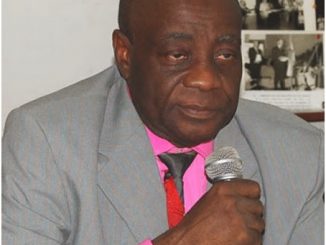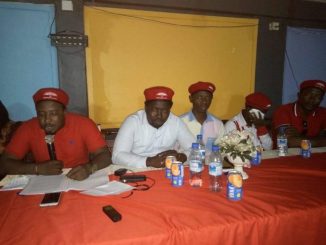
Sierra Leone discovers new deposits of diamond, bauxite, iron ore, gold, rutile and nickel
Sierra Leone, one of the poorest nations in the World despite an abundance of mineral resources valued at Trillions of Dollars, has announced new discovery of massive deposits of kimberlite diamond, iron ore, gold, bauxite, rutile and nickel. This was revealed in a speech delivered by President Bio early this week – Monday, 24th May, at the launching of geo-data produced by the country’s Minerals and Mines Agency.

Speaking at the event, President Bio said: “Ladies and Gentlemen, I am pleased therefore to announce that the outcome of the airborne geophysical survey confirms the occurrence of more Kimberlites, Bauxite, Iron Ore, Gold, Rutile, and Nickel. It also provides high-resolution geological information with untold potential for targeting rare earth elements such as Cerium and Neodymium; battery metals such as Lithium and Graphite; Base metals; Platinum Group Metals; ethically sourced Coltan, and a range of other internationally desirable commodities for low carbon and digital technologies.”
It is expected that, if these new discoveries are properly managed, and corruption and poor governance kept at bay, the people of Sierra Leone should come out of poverty by 2030, with each region having its own state of the art hospital, good roads, modern educational institutions, high growth industries, good quality housing, clean and safe drinking water, as well as access to reliable supply of electricity.
This is the full statement of President Bio delivered at the event:
“Let me once again welcome you to the launch and exhibition of the Geodata of Sierra Leone’s first ever airborne geophysical survey. Welcome to our peaceful democracy. Welcome to our beautiful and scenic Sierra Leone. COVID-19 has wreaked havoc across the world. We were proactive and we have remained vigilant. We are a low-risk nation, but we will continue working harder using our home-grown expertise and technology solutions, resources, and the support of friends to continue working our way down toward comprehensive vaccination and prevention measures.
But more importantly, COVID-19 has shattered the economies of countries. The mining sector has not been spared as investment financing constraints, supply chain and production disruptions, and low output have slowed down new developments and investments in the sector. Thankfully, Sierra Leone has been spared the worst and we have stayed engaged with the Sierra Leone Chamber of Mines in the best interests of the sector.
The sector is assured that my Government is eager to work with and support current investors to amicably resolve and also manage their unique constraints. We are here always, and we are here for you in all ways.
To our guests, we are grateful for your presence and for your keen participation in this event. Your presence also reminds us that there is great interest in and immense value to our extractives sector especially given the new datasets that have been generated by the airborne geophysical survey.
I want to thank the World Bank for its staunch support through the Extractive Industries Technical Assistance Project 2 – EITAP 2. In both our New Direction Manifesto and our country’s Medium-Term National Development Plan, the components of the EITAP 2 project, as outlined earlier by the World Bank representative, are aligned with our strategic objectives to strengthen governance, knowledge, and sustainability of the extractives sector in Sierra Leone, and to maximise its contribution to our national development.
I also want to thank the Parliamentary Committee on Mines and Mineral Resources and its very eloquent Chairman, Honourable Saa Emerson Lamina. He has reminded us and appropriately so that “the minerals we have are not renewable minerals.”
Permit me, Honourable Chairman, to add that because they are not renewable, we must govern the extractives sector diligently so that it benefits our investors, our communities, the nation, and our environment. Let us use those non-renewable resources therefore as we may not have done in the last 90 years. Let us use them to facilitate inclusive and sustainable national development. I thank you for your leadership in championing progressive legislation for the extractives sector. Thank you.
I also want to thank the leadership, board, and staff of the Ministry of Mines and Mineral Resources and the National Minerals Agency. In spite of challenges and constraints, you continue to do a yeoman’s job and competently and assiduously so. The support by Reid Geophysics Limited has also been invaluable. Thank you.
I am not here to do a symbolic launch and walk away to my office. I am here to speak to friends, partners, and potential investors present and not present. I am here to share with you what we have done about the mining sector over the last three years.
I am also here to listen very keenly to your thoughts, ideas, and experiences. I want to assure you that we will create even more opportunities to sit down and talk; to think together; to cooperate; to reach consensus; and to work together to further develop the extractives sector and make it even more viable for investors and their shareholders, the Government, communities, and the country as a whole.
As I have always said, I want that relationship to be built on mutual trust with all parties being transparent, patient, and clear about pursuing a win-win outcome.
The Minister of Mines and Mineral Resources and the Director General of the National Minerals Agency informed us earlier that in 2018 we had six large-scale operations mining rutile, ilmenite, bauxite, and diamonds. In 2021, we now have eleven large-scale mining companies in operation mining diamonds and more metal ores.
The strategic plan of the National Minerals Agency has also been explained by the Deputy Director-General. The plan takes into account deficiencies in existing structures, technical skills and personnel, coordinating mechanisms, legislation, and activities. In totality, as the Deputy Director-General pointed out, we now have a strategy, plan of action, and documents that will help us move into the next phase of managing our extractives sector.
As noted earlier, our strategic plan is anchored in sub-cluster 2.6, “Improving Mineral Resource Management” of our Medium-Term National Development Plan. The cluster expands and leverages principles, strategies, and actions found in both the ECOWAS Mining Directive and the African Mining Vision.
Previous speakers have also provided the technical detail associated with the Nationwide Airborne Geophysical Survey. I am informed that because we used close-line spacing and low ground clearance, we have generated one of the best high-resolution countrywide geophysical data in the world.
The Director-General has highlighted that we now have a better understanding of the Geodata and the possible suite of 4IR technologies that are available for us to present and manage our Geodata. We have also crafted our nation’s first ever Geodata Management Policy.
But we have also been working on the ecosystem for win-win investments in the extractives sector. Our peaceful democracy has recently been selected to develop a Millennium Corporation Challenge Compact for consistently passing the control of corruption indicator, ruling justly, and for respecting economic freedoms. Our laws and regulations that protect investments meet international best standards. From the perspective of the country’s best interests and those most affected by mining activities, my Government works to promote transparent, fair, and equitable agreements.
Sierra Leone is also fully compliant with international transparency mechanisms for the extractives sector. We made history as the first country to adopt the Kimberley Process Certification Scheme to regulate the trade in diamonds and we have been fully compliant ever since. Sierra Leone is also fully compliant with the Extractives Industry Transparency Initiative and we maintain an online repository to ensure transparency in the licenses administration and management process.
Even in the midst of COVID-19, international financial institutions have praised our handling of the macroeconomic fundamentals and our public financial management. Inflation is down into single digits for the first time in six years and the value of our currency has relatively stabilised against regional currencies.
Our reserves have grown over the last three years. Although overall debt distress is rated as “high,” the International Monetary Fund has praised my Government’s strong commitment to implementing reforms and making debt servicing sustainable. We are averse to resource-backed dark debts because we believe it is a public finance risk.
We have indeed worked very hard over the last three years to make the fiscal space for mining investments transparent, fair, stable, and predictable. The Extractives Industries Revenue Act and the Finance Act are comprehensive documents. We are committed to making more progress and making that fiscal space very competitive in the West Africa region.
By all traditional measures of political risk, Sierra Leone is a stable and peaceful democracy where we hold elections in predictable and peaceful elections cycles. According to the Global Peace Index, we are the fifth most peaceful country in all of Africa, and along with Ghana, we are the top two most peaceful countries in West Africa. We have moved up ten places in World Press Freedom rankings. No journalist is in prison for the practice of journalism and the safe, open, and secure practice of journalism is assured.
As a Government, we respect the sanctity of life and we are fully committed to abolishing the death penalty. We have been favourably cited by international institutions and other countries for our work on gender, inclusion, and child rights especially for investing in people and in the right to inclusive quality education. We have set up a statutory and Independent Commission for Peace and National Cohesion and we are closely engaged with civil society.
Over the last three years, we have undertaken comprehensive institutional reforms in order to make our institutions more effective. We have worked to remove red tape and streamline processes. The Vice President and I are closely involved with the National Investment Board and we can assure friends that we are always available and most willing to unlock bottlenecks.
We are harmonising laws and policies in order to avoid duplications and conflicting mandates across Ministries, Departments, and Agencies (MDAs). We want them also to work speedily to help potential investors set up, resolve initial and ongoing issues, and be able to report a pleasant experience to other potential investors.
The Ministry of Mines and Mineral Resources has been authorised to engage very closely with the Sierra Leone Chamber of Mines. Let us keep working together. Henry Ford, the great American industrialist, once said “Coming together is a beginning. Keeping together is progress. Working together is success.”
My Government wants to work together with the Chamber of Mines to resolve potential issues, respond to concerns, and listen keenly to recommendations from Chamber members on how best we can work towards mutually beneficial win-win outcomes in the sector.
My argument is simple. If you are looking for a safe, stable, and supportive country in which to invest in the extractives sector, look no further. Sierra Leone is that prime destination. We have stated the urgent need for integrated infrastructure to be developed around the mining sector.
There are real opportunities for a robust modern energy system to underpin the expansion of the mining sector and also facilitate processing and value-addition in-country. The “dig and ship-away raw” approach to mining has not been as beneficial to our small economies. We also believe that integrated infrastructure development can be catalytic for development beyond the mining sector.
As a country, Sierra Leone is also keen on working with partners who are interested in sustainable investing and who are mindful of environmental, social, and governance issues. We have worked hard to sanitise the sector. We expect that our friends who wish to operate in the sector share our values of open disclosures, so all parties avoid unpleasant surprises and adversarial relations. Also, we expect that our investors are patient, and they are or will be vested in the sector for a long time.
While they are here and making positive returns for their shareholders, they should also be mindful of the long-term impact of their work and presence on local communities and their Sierra Leonean workforce. They should not also forget that community development and corporate social responsibility are essential elements of their responsibility to local communities.
We insist on local content in all its forms. Health and occupational safety, labour relations, and skills training for Sierra Leoneans are all very important to us as a Government and as a country.
We are also mindful of the negative impact of the entire mining cycle on the land, water, air, ecosystems, and human health. Inasmuch as we are flexible on the payment of costs for environmental liabilities, we expect that investors are fully committed to ecosystem risk management, mine closure and rehabilitation issues, and the management of water from their operations, among a host of environmental concerns.
Indeed, I am in accord with the Chairman of the NMA when he called for “a thoughtful and responsible approach to mining” and also for “sustainable alternative livelihoods for our mining communities.” In essence, my call is that we balance the making of healthy profits with responsibility for the footprint of the investment on the environment, workers, and communities.
So, when we say Sierra Leone is the best destination for your mining investment portfolio, it is because we have made great progress on making the sector conducive for investment.
As a nation, we have announced our commitment to the Paris Agreement on Climate Change. We have also associated with green development initiatives. We believe that a low to zero carbon future is possible. In this digital age, there is an insatiable global appetite for metals that support low carbon technologies. Sierra Leone stands ready to contribute to the global supply of those metals.
The real value of this comprehensive geoscientific data and information, as previous speakers have intimated, is that it will effectively cut down on time, costs, risks, and preparatory work for both greenfield mine start-ups and brownfield mine reworks. But this high-quality dataset also provides valuable information for hydrological, environmental, infrastructure, and agricultural management.
Ladies and Gentlemen, I am pleased therefore to announce that the outcome of the airborne geophysical survey confirms the occurrence of more Kimberlites, Bauxite, Iron Ore, Gold, Rutile, and Nickel. It also provides high-resolution geological information with untold potential for targeting rare earth elements such as Cerium and Neodymium; battery metals such as Lithium and Graphite; Base metals; Platinum Group Metals; ethically sourced Coltan, and a range of other internationally desirable commodities for low carbon and digital technologies.
Let me, therefore, conclude by welcoming you to this formal launch, urge you to network and ask questions, and encourage you to consider investing in the huge resource potential indicated by the result of our nation’s first ever airborne geophysical survey. With this, I now formally launch the Geodata and declare its associated exhibition open. I thank you.” (END)



